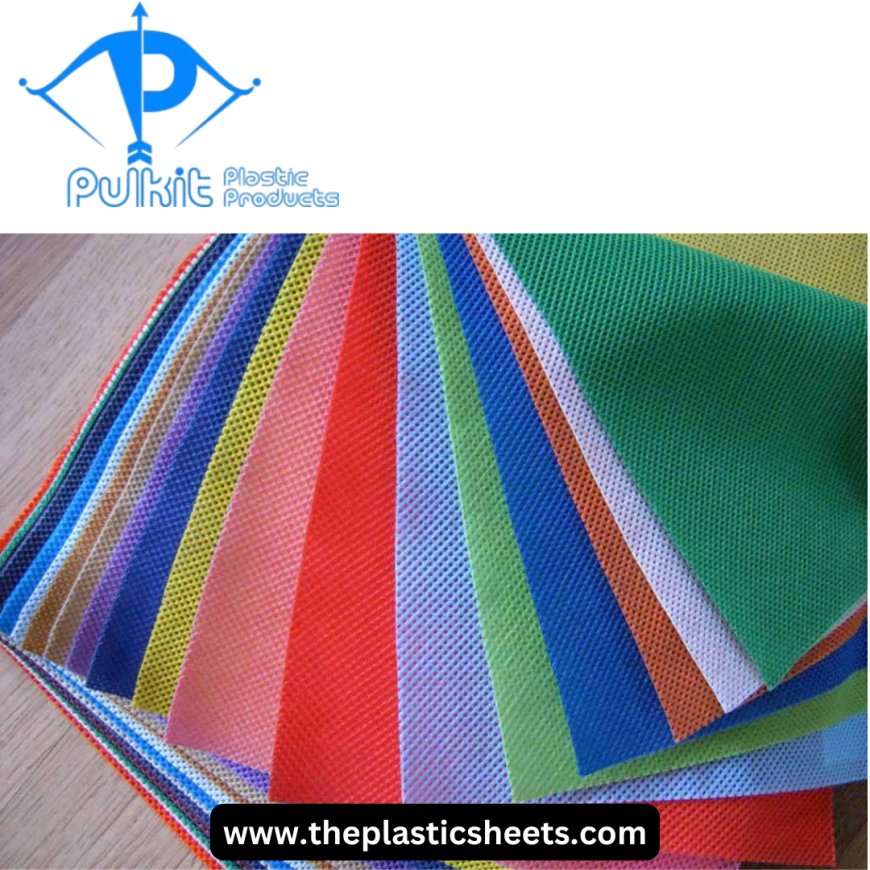A Comprehensive Guide to PP Spunbond Nonwoven Fabric: Properties, Applications, and Advantages

PP spunbond nonwoven fabric has emerged as a crucial material across various industries due to its unique characteristics and versatility. This Pulkit Plastic Products explores the nature of PP spunbond nonwoven fabric, its key properties, applications, advantages, and answers to frequently asked questions to provide a thorough understanding of this essential material.
What is PP Spunbond Nonwoven Fabric?
Spunbond Nonwoven Fabric is a type of synthetic fabric made from polypropylene (PP) fibers that are bonded together through a process called spunbonding. Unlike woven fabrics, which are created by interlacing threads, nonwoven fabrics are produced by directly bonding fibers together, resulting in a strong, durable, and versatile material.
The spunbonding process involves melting polypropylene pellets, extruding them into continuous filaments, and then laying these filaments onto a conveyor belt. The filaments are then heated and bonded together, creating a fabric that can be used in various applications.
Key Properties of PP Spunbond Nonwoven Fabric
PP spunbond nonwoven fabric possesses several notable properties that make it an ideal choice for various applications:
-
Strength and Durability: The bonding process gives the fabric high tensile strength, making it resistant to tearing and puncturing. This durability is crucial for applications that require robust materials.
-
Lightweight: PP spunbond nonwoven fabric is significantly lighter than traditional woven fabrics, making it easy to handle and transport.
-
Water Resistance: The nonwoven structure provides excellent water resistance, allowing the fabric to repel moisture, which is beneficial for many applications.
-
Breathability: Despite being water-resistant, PP spunbond nonwoven fabric is breathable, allowing air and moisture vapor to pass through. This property is essential in applications such as medical and hygiene products.
-
Chemical Resistance: The polypropylene material is inherently resistant to many chemicals, acids, and bases, making it suitable for various industrial applications.
-
Customization: PP spunbond nonwoven fabric can be produced in various colors, thicknesses, and finishes, allowing for customization to meet specific requirements.
Common Applications of PP Spunbond Nonwoven Fabric
PP spunbond nonwoven fabric is used in a wide range of industries, showcasing its versatility:
1. Medical and Hygiene Products
In the medical field, PP spunbond nonwoven fabric is widely used for manufacturing surgical gowns, masks, drapes, and other disposable items. Its breathability, fluid resistance, and comfort make it ideal for these applications, helping to ensure safety and hygiene in healthcare settings.
2. Agriculture
PP spunbond nonwoven fabric is used in agricultural applications for crop covers, plant protection sheets, and mulching films. Its lightweight and UV-resistant properties protect plants from pests, harsh weather, and soil erosion, promoting healthier growth.
3. Packaging
In the packaging industry, PP spunbond nonwoven fabric is employed for producing bags, pouches, and protective covers. Its strength and durability make it suitable for packaging a wide variety of products, from food items to industrial materials.
4. Geotextiles
PP spunbond nonwoven fabric is commonly used in civil engineering and construction as geotextiles. These fabrics provide soil stabilization, erosion control, and drainage, making them essential for infrastructure projects.
5. Automotive Applications
In the automotive industry, PP spunbond nonwoven fabric is used for manufacturing interior components, insulation materials, and sound-absorbing products. Its lightweight nature helps reduce overall vehicle weight, contributing to fuel efficiency.
6. Home Textiles
PP spunbond nonwoven fabric is increasingly used in home textiles, such as curtains, tablecloths, and bedding. Its durability and easy maintenance make it a popular choice for home furnishings.
Advantages of PP Spunbond Nonwoven Fabric
Non Woven Spunbond offers numerous benefits that contribute to its growing popularity:
1. Cost-Effectiveness
PP spunbond nonwoven fabric is generally more affordable than many woven fabrics, making it a cost-effective choice for manufacturers and businesses.
2. Environmental Impact
PP spunbond nonwoven fabric is recyclable, and many manufacturers are focusing on sustainable production methods. By choosing this material, businesses can reduce their environmental footprint.
3. Versatility
The wide range of applications for PP spunbond nonwoven fabric demonstrates its versatility. It can be used in industries ranging from healthcare to agriculture, showcasing its adaptability.
4. Ease of Processing
PP spunbond nonwoven fabric can be easily cut, sewn, and bonded, making it simple to work with during the manufacturing process. This ease of fabrication contributes to efficient production.
5. High Performance
The unique properties of PP spunbond nonwoven fabric, such as strength, durability, and water resistance, ensure high performance in various applications, meeting the demands of diverse industries.
Conclusion
Spun Bonded Non Woven Fabric is a highly versatile and durable material widely used across various industries due to its excellent properties and adaptability. From medical and hygiene products to agricultural applications and automotive components, PP spunbond nonwoven fabric offers numerous advantages, including cost-effectiveness, ease of processing, and high performance. As the demand for sustainable and efficient materials continues to grow, PP spunbond nonwoven fabric stands out as an innovative solution that meets the needs of modern industries. Understanding its properties, applications, and benefits can help manufacturers and consumers make informed choices that contribute to a more sustainable future.
Frequently Asked Questions (FAQs)
1. What is the difference between spunbond and meltblown nonwoven fabrics?
Spunbond nonwoven fabric is made by extruding continuous filaments and bonding them together, resulting in a strong, durable fabric. Meltblown nonwoven fabric, on the other hand, is made by extruding molten polymer through small nozzles, creating fine fibers that are collected and bonded together. Meltblown fabrics are often used for filtration applications due to their finer fiber structure.
2. Is PP spunbond nonwoven fabric biodegradable?
PP spunbond nonwoven fabric is not biodegradable, but it is recyclable. Many manufacturers are exploring eco-friendly alternatives and sustainable production methods to minimize environmental impact.
3. Can PP spunbond nonwoven fabric be printed on?
Yes, PP spunbond nonwoven fabric can be printed on using various printing techniques, allowing for customization and branding for specific applications.
4. How do I care for products made from PP spunbond nonwoven fabric?
Products made from PP spunbond nonwoven fabric are generally easy to care for. They can often be cleaned with mild soap and water, and many items are machine washable.
What's Your Reaction?



























